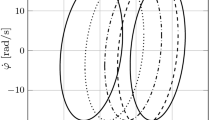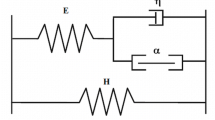Abstract
A general myocybernetic control model of skeletal muscle is presented which constitutes an extension, to general control modes, of a previously published control model. The restriction, in the previous model, to a constant number of stimulated motor units has been removed and the new model allows for both a varying number of stimulated motor units and a varying average stimulation rate. The general model is tested by comparing its predictions with experimental records of the force output of the quadriceps femoris muscle. It is found that the model correctly predicts the initial excitation-contraction delay, the dips in the force record, and several other contraction phenomena.
Similar content being viewed by others
References
Bahler, A.S., Fales, J.T., Zierler, K.L.: The active state of mammalian skeletal muscle. J. gen. Physiol. 50, 2239–2253 (1967)
Briggs, F.N., Poland, J.L., Solaro, R.J.: Relative capabilities of sarcoplasmic reticulum in fast and slow mammalian skeletal muscles. J. Physiol. 266, 587–594 (1977)
Calvert, T.W., Chapman, A.E.: The relationship between the surface EMG and force transients in muscle: simulation and experimental studies. Proc. IEEE 65, 682–689 (1977)
Chow, C.K., Jacobson, D.H.: Studies of human locomotion via optimal programming. Math. Biosci. 10, 239–306 (1971)
Coddington, E.A., Levinson, N.: Theory of ordinary differential equations (pp. 13–61). New York: McGraw-Hill 1955
Desmedt, J.E., Godaux, E.: Ballistic contractions in man: characteristic recruitment pattern of single motor units of the tibialis anterior muscle. J. Physiol. 264, 673–693 (1977)
Ebashi, S., Endo, M.: Calcium and muscle contraction. Progr. Biophys. 18, 123–183 (1968)
Edman, K.A.P., Mulieri, L.A., Scubon-Mulieri, B.: Non-hyperbolic force-velocity relationship in single muscle fibres. Acta physiol. scand 98, 143–156 (1976)
FitzHugh, R.: A model of optimal voluntary muscular control. J. Math. Biol. 4, 203–236 (1977)
Gibbs, C.L., Gibson, W.R.: Energy production of rat soleus muscle. Amer. J. Physiol. 223, 864–871 (1972)
Grimby, L., Hannerz, J.: Firing rate and recruitment order of toe extensor motor units in different modes of voluntary contraction. J. Physiol. 264, 865–879 (1977)
Hatze, H.: The complete optimization of a human motion. Math. Biosci. 28, 99–135 (1976)
Hatze, H.: A myocybernetic control model of skeletal muscle. Biol. Cybernetics 25, 103–119 (1977a)
Hatze, H.: The relative contribution of motor unit recruitment and rate coding to the production of static isometric muscle force. Biol. Cybernetics 27, 21–25 (1977b)
Hatze, H.: A teleological explanation of Weber's law and the motor unit size law. CSIR Special Report WISK 248 (1977c)
Hatze, H., Buys, J.D.: Energy-optimal controls in the mammalian neuromuscular system. Biol. Cybernetics 27, 9–20 (1977)
Henneman, E.: Peripheral mechanisms involved in the control of muscle. In: Medical Physiology, pp. 1697–1716. Mountcastle, V.B., ed. St. Louis: Mosby 1968
Henneman, E., Somjen, G., Carpenter, D.O.: Excitability and inhibitability of motoneurones of different sizes. J. Neurophysiol. 28, 597–620 (1965)
Jewell, B.R., Wilkie, D.R.: The mechanical properties of relaxing muscle. J. Physiol. 152, 30–47 (1960)
Jöbsis, F. F., O'Connor, M.J.: Calcium release and reabsorption in the sartorius muscle of the toad. Biochem. Biophys. Res. Commun. 25, 246–252 (1966)
Julian, F.J.: The effect of calcium on the force-velocity relation of briefly glycerinated frog muscle fibres. J. Physiol. 218, 117–145 (1971)
Kernell, D.: The limits of firing frequency in cat lumbosacral motoneurones possessing different time course of afterhyperpolarization. Acta physiol. scand. 65, 87–100 (1965)
Milner-Brown, H.S., Stein, R.B., Yemm, R.: The orderly recruitment of human motor units during voluntary isometric contractions. J. Physiol. 230, 359–370 (1973)
Person, R.S., Kudina, L.P.: Discharge frequency and discharge pattern of human motor units during voluntary contraction of muscle. Electroenceph clin. Neurophysiol. 32, 471–483 (1972)
Smith, G.L.: Biomechanical analysis of knee flexion and extension. J. Biomechanics 6, 79–92 (1973)
Stark, L.: Neurological control systems, p. 311. New York: Plenum Press 1968
Thorstensson, A., Grimby, G. Karlsson, J.: Force-velocity relations and fiber composition in human knee extensor muscles. J. Appl. Physiol. 40, 12–16 (1976)
Wendt, I.R., Gibbs, C.L.: Energy production of rat extensor digitorum longus muscle. Amer. J. Physiol. 224, 1081–1086 (1973)
Author information
Authors and Affiliations
Rights and permissions
About this article
Cite this article
Hatze, H. A general myocybernetic control model of skeletal muscle. Biol. Cybernetics 28, 143–157 (1978). https://doi.org/10.1007/BF00337136
Received:
Issue Date:
DOI: https://doi.org/10.1007/BF00337136




